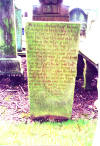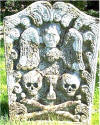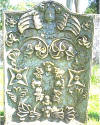|
Gravestones and Memorials in Scotland.
Surprising as it may seem there were not many gravestones
for the common man or woman before the Reformation,
only some temporary markers and perhaps the occasional
`chest` type of tomb of a local laird or merchant
who could not secure a coveted space inside the kirk.
Those with status and money would be buried within the
church itself, perhaps donating a side chapel
or aisle in memoriam of their loved ones with
continued use by the family.
 A A
prime example are the magnificent Queensberry Marbles –
the Duke of Queensberry memorial in Durisdeer Kirk. At
another extreme is the cringingly sycophantic memorial to
Archbishop James Sharp,
murdered in 1679. Otherwise at this time most common
people were buried in unmarked graves which overlaid
earlier burials. Indeed prior to the Reformation the
churchyard was not necessarily regarded as hallowed
ground and used for many civil or social activities
including musters (wappinschaws), archery practice, fairs and market
places.
In Stones – 18th
Century Scottish Gravestones, (Canongate Pub. Edinburgh 1978) Betty
Wiltshire and Doreen Hunter explain in depth the treasury of Scottish
monuments. They point out that the development of grave memorials
reflected the stone mason`s art and was more apparent in England in the
17th century where J Weever, in A Discourse of Funerall Monuments
(London 1631) described the then practice
In all ages
people flock to look at monuments and ruins. … they put us in mind
of our own mortality and consequently bring us to an unfained
repentance. Neither can we pass by but with yearning hearts look upon that
famed soile …
Sepulchres
should be made according to the quality and degree of the deceased person
… persons of a plebian sort shall be bvuried without any tomb or
gravestone or epitaph; persons of the meanest sort of gentry a flat
gravestone. Gentlemen of more eminence…. effigies and representations
cut upon a terme or a pedestal, but no arms.Noblemen and princes and kings
had their sepulchres raised aloft and their personages delineated, carved,
embost, the full length and bigness in alabaster, rich marble ….
epitaphs were only for such as were of virtue, wisdom , valour
It was only in the
early 17th century that marker stones became more common amongst the
relatively well-to-do in Scotland. This was both a realisation and
acceptance of the reformed faith that the individual could approach God
direct. It was no longer the belief and practice to seek intercession
through the Catholic church. A second and important factor was the
relative improvement in earnings and development of a social order. This
saw the common man scrimping together money to buy a stone and have it
ornamented by a mason; this also led to development of a pictorial
shorthand that amongst other things, expressed the donors views, hopes of
eternal life, and their trade eg merchant. As the markers evolved to one
at the foot and another at the head, so did the idea that commemorative
inscriptions and emblems could be applied to the head stone. It was
the middle of the17th century before the common people were able to afford
to set up monuments. The larger commemorative stones of winged angels and
the like beloved of the Victorians did not emerge until the 19th century.
The
increase in the number of memorials after the Reformation
perhaps reflects the growing importance of individual
identity as well as personal wealth. The 16th
and 17th centuries saw many outbreaks of
plague, including the Black Death or bubonic plague, which
called for very quick internment often in unmarked lime
pits away from the town. Other killer diseases which
flourished in the heavily populated and unsanitary slums
of towns and cities were cholera, typhoid and
smallpox. These took a terrible toll, especially among the
children – over half of all children died before they were
twelve years old. Adults were commonly dying in their
early forties overtaken by sheer hard work of eking an
existence, probably suffering from bouts of consumption
(Tuberculosis) and the gravel ( stones in the urinary
tract) which was very common through poor diet. Throughout
the 17th century tens of thousands died from
military service, both killed in battles and from `camp
fever` (usually typhus), imprisonment and deportation as
prisoners of war.
The
earliest graves outside the church are usually to be found
on the south side , on either side of the path and near
the nave and chancel walls. As this area filled with
memorials, burial spread further away
 from from
the church, around the east and then the west end.
Finally, the north side was used, when necessity overcame
a belief that it was unlucky and associated with the
Devil. Gradually there began to be a cluster of family
plots that often reflected several generations of the
local community. In the the Old Dalgarnock Kirk Yard for
example there are many graves of the Covenanting family
– the Harknesses.
The
decoration of grave stones for the common man evolved
through the 17th century as it became custom
and practice to erect a stone. It reflected to some extent
an increasing wealth as family graves and family monuments
were commissioned, and also a gradual divergence from the
strictures of the kirk. There was also a sea change
in attitudes as the Reformation and Presbyterianism took
hold. This saw a change of the type of emblems that were
used on gravestones. Pre Reformation they
 were were
symbols of Mortality such as the Deaths Head; skull and
cross bones; Father Time; the weapons of death – bow,
arrows, scythe; a corpse wrapped in its winding sheet;
snakes perhaps with an apple signifying the Fall of Man.
There was also the bell – the `Deid Bell` as it was
called, which was rung at funerals.
 The The
main church bell could be rung on payment of a fee,
otherwise a hand bell was used. The Reformation ushered in
an awareness of equality of man in the sight of God and
the right to communicate directly with Him. The emblems
then began to change to those of Immortality overcoming
Death reflecting the certainty of the Resurrection and
eternal life through Christ Jesus. The emblems of
Immortality included the winged soul or cherub ;
angels of the Resurrection with trumpets flying through
the air; the Glory or Radiance of God as portrayed
in sunbursts and sun rays; torches which if upward and
flaming were of eternal life, and if inverted the end of
earthly life; the Agnus Dei; the Phoenix, and the
Pelican denoting
piety as it feeds its young with its own blood.
 There There
were many other used in decorations such as the rosette,
the scallop shell of the pilgrim, the Crown (of
Righteousness); the palm, bay leaves and laurel
of victory over death; the heart as a symbol of the
soul and the Resurrection, and the scales for weighing the
soul come Judgment Day. Towards the end of the 17th
century there was considerable use of
tools of trade in the
memorials and reflected the growth and eventual primacy of
the Guilds over the merchants. However, their use, died
out in the 18th century.
Increasing population, the industrial revolution and
growth of larger towns and cities no doubt contributed to
pressure on available space in kirkyards. As a result
there was the development of the necropolis with its
`lairs` – a purpose built burial ground often intended for
the `better classes`. The common people were buried
in cemeteries, open for all denominations. Over time the
wish to erect memorials would not have helped the
overcrowding and has contributed to modern day demolition
and clearances. What we are now seeing is the
disappearance of much of our heritage as even fairly
modern memorials are destroyed by vandals, including the
development vandals who can hardly wait to build another
parking lot or superstore. Much good work is being done by
the Council for Scottish Archaeology whose web site at
www.britarch.ac.uk/csa/
is well worth a visit. It is a
voluntary membership organisation which works to secure
the archaeological heritage of Scotland for its people
through education, promotion and support of local
initiatives.
The Scottish Covenanter Memorials Association
was established in 1966 with the objective of preserving
the graves and memorials of the Covenanters. Also a
voluntary membership registered charity it is well worthy
of your support. Their web site and contact details are at
http://www.covenanter.org.uk/
.
Further Reading:
Betty Willshire
Understanding Scottish Graveyards (Council for British
Archaeology Scotland 1985)
Anne Gordon, Death is for the Living. (P Harris,Edbh 1984.)
Back
to Old Mortality.
18/07/2011
|